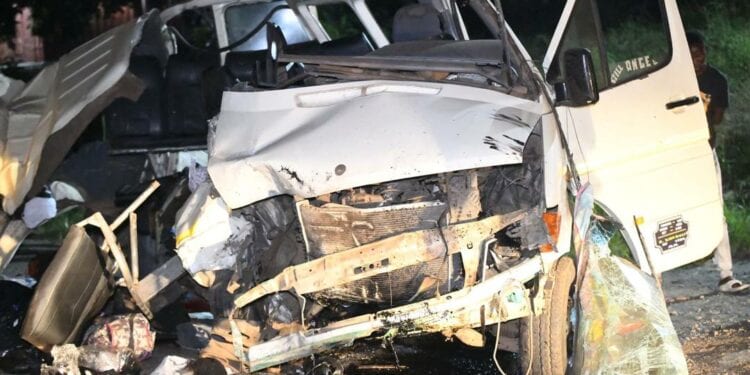Carnage On Our Roads – Tripod Beta Perspective

Almost 9 people have died each day on our roads since the beginning of the year 2021. Road crashes are taking lives more than Covid-19, yet I dare say that the heightened euphoria, sensitisation, commitment, mass education and mobilisation of resources to combat Covid -19, far outweighs and exceeds that for road crashes.
The debate on curbing the menace on our roads have commenced again, after reports of crashes in the past week, and Joy News airing of their documentary “Crushed”.
Several solutions have been proffered, including the need to commence detailed and broader consultative sessions on the road menace. I believe the best approach is to employ a methodology that can elicit all the nuances relative to the menace on our road, analyse them and develop sustainable solutions. TRIPOD BETA methodology is one such model. It enables a deeper understanding of how accidents/incidents happen using the Swiss Cheese model. It also helps to uncover deep rooted entity deficiencies to be addressed.
There are several personalities in Ghana who are well vested in this methodology and can be called upon, to lend their knowledge and expertise to help curb this menace.
In my brief years of industry training, practice and experience, I have come to realise that;
- Most accident investigations end up with Immediate Causes being classified as Root Causes.
- As a result, controls or remedies that are designed for these “Root/Immediate Causes”, do not last to achieve the objectives for which they were designed.
- Because investigations into incidents/accidents often stop at the perceived “Root Cause” level, the actual cause which is the highest level of cause, are mostly not identified and analysed or, identified but not analysed in detail to elicit suitable controls.
Apart from natural effects (often termed acts of God), accidents do happen when Control Barriers fail. Failure of control barriers are mainly borne out of Human action or inaction. The driver and passenger who should have worn seat belts but chose not to wear, the vehicle which should be equipped with seatbelt before occupancy but not done, the driver who should have sent the vehicle for repair maintenance but chose to load instead, the driver who should have had enough rest the night before but chose to hang out all night getting up early dawn (already fatigued) to pick innocent commuters, the station master and police officer who should have stopped that rickety/overloaded vehicle at the loading bay and on the road but didn’t, the vehicle testing officer who should have denied the vehicle a road worthiness certificate but gave it out, the driver testing officer who should have failed the driver applicant because he could not drive but issued it out…. These sub-standard human actions or inactions cause the Control Barriers (seat belt, routine maintenance, pre-load inspections, rest, on-road vehicle inspections, duty hour schedules, road worthy certificate, driver’s licence, etc..) to fail, resulting in an accident. The human actions or inactions are termed Immediate Cause.
Controls Designed to Remedy “Immediate Causes” Will Always Fail to Achieve the Desired Results.
The above statement is true because, Tripod Beta Incident Investigation methodology has proven that immediate causes do not occur in a vacuum but triggered or enabled by Precursors, which are the enabling conditions or environments that gives room for this human activity/inactivity listed above to fester. Also termed “Pre-conditions”, these in relation to the sub-standard actions or inactions listed above could be; defective or no seat belt, poor or no safety and maintenance culture, improper work-life balance, ineffective or no work-shift regime, obsolete, outdated or no Control Barriers, absence or ineffective staff monitoring and evaluation practices, among many others.
It is important to note that sometimes, some analysis of accidents clearly classify the Immediate Causes, but end up classifying the Preconditions (examples listed above) to the Immediate causes as “Root causes”. As a result, such investigations conclude by proffering controls/remedies on the identified “Root causes”, instead of going further.
Controls designed to remedy these identified “Root causes” will also always fail to achieve the desired results.
The above statement is also true because the Preconditions identified, also do not appear, or exist in vacuum. Preconditions are created, managed, controlled and even destroyed by “Underlying Factors”. Underlying Factors are the high-level management systems, cultures and or norms that underpin the existence or otherwise of Preconditions. These include higher level management and system failures, absence of or lack of clarity in policies, procedures, responsibilities and accountabilities, absence of or poor leadership visibility, absence or ineffective risk management systems, entity culture, entity beliefs, among others.
These are the elements that create and control Preconditions, enabling human activity/inactivity to fester and break existing control barriers.
The outcome is an accident.
Take Home
- Strong, effective, and efficient controls applied to Underlying Factors, coupled with strong, effective and efficient Barrier Controls will always succeed in achieving desired results.
- Until the nation focusses on a Suitable Methodology to identifying and improving Control Barriers and Underlying Factors, accidents/incidents will not see a decline.
- I fully support a call for a national dialogue and brainstorm sessions, to use proven methodologies to find sustainable solutions.
- It will not be an easy road, as I see drastic reforms (including legal reforms) in our transport management and leadership approach, and reforms in our investigation methodologies, as some of the probable outcomes to solve this menace.
Road crashes and rollovers in the white oil road transport sector relative to transporters for entities like Shell, ZEN, PUMA, TOTAL, GOIL are low to non-existent.
What is it that they are doing so right? Can’t it be considered and tailored to other public transport sectors backed by some form of legislation?
Author: Eric Bonsu Agyabeng
The author is Manager, Technical Advisor, Transport and Logistics, PME Division of the State Interests and Governance Authority (SIGA). Views expressed in this article are entirely the author’s and do not in any way represent those of the Media General Group or any of its affiliate outlets.










